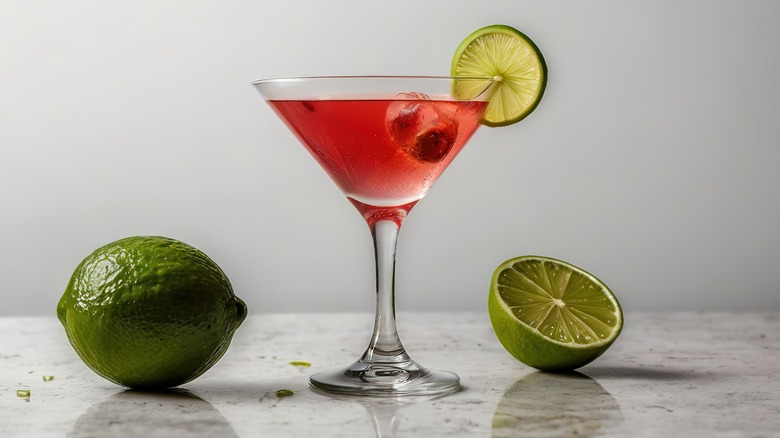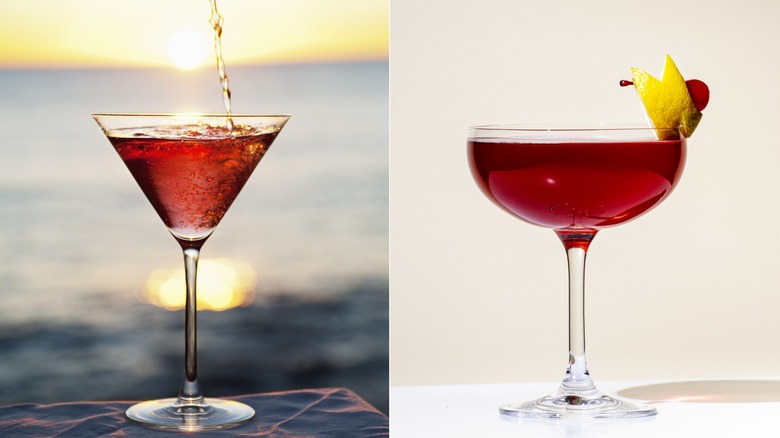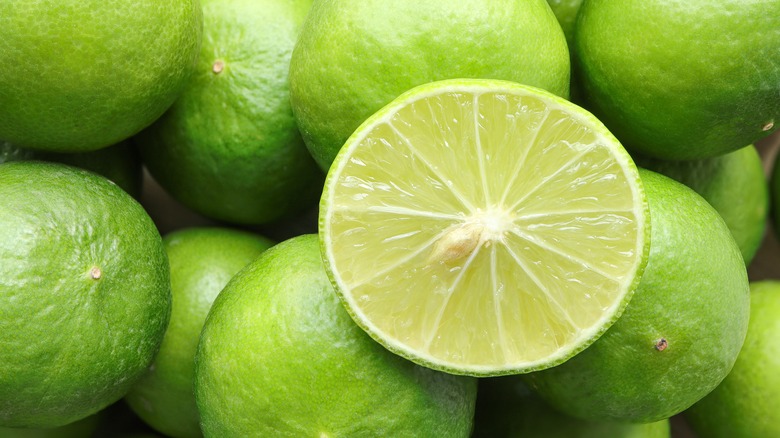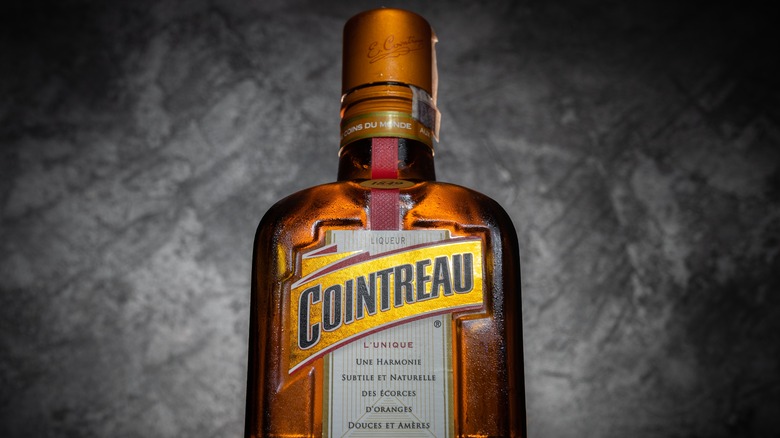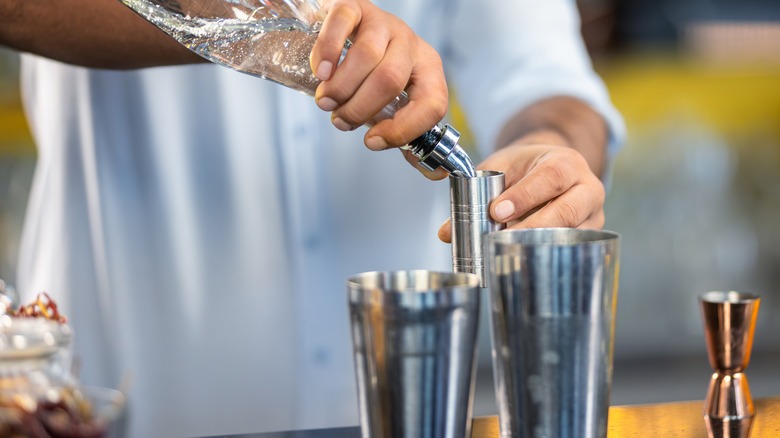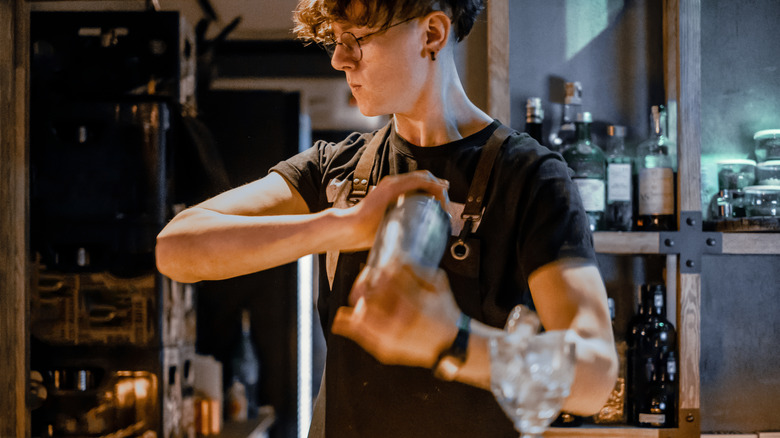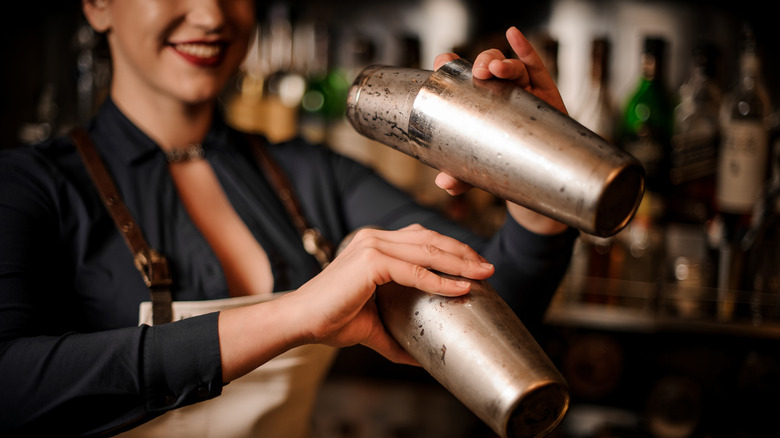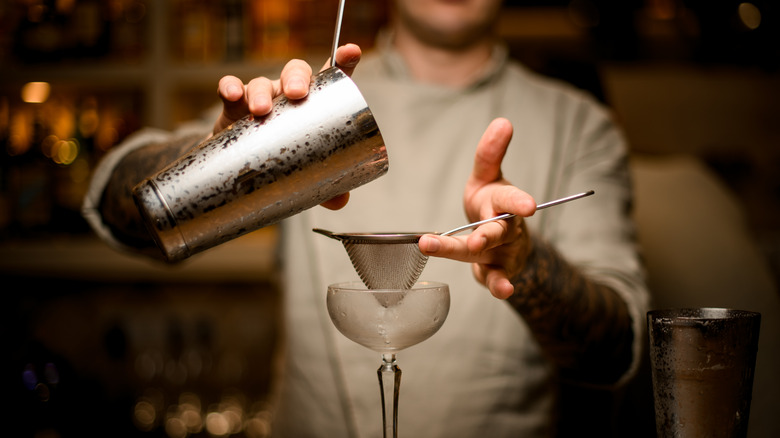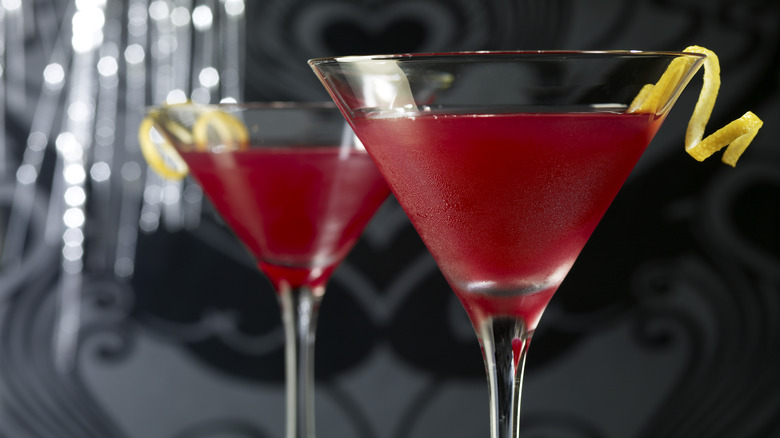11 Tips You Need For The Best Cosmopolitan Cocktails
It's 1988 and the day after the 30th Grammy Awards, a star-studded event watched by nearly 33 million. The newspapers are filled with shots documenting the world's most famous music stars mixing and mingling. Madonna's been photographed drinking a mysterious light pink cocktail throughout the evening, and it won't be long before the name "cosmopolitan" is on everyone's lips.
A decade later, HBO's "Sex and the City" brought the cosmopolitan back into the spotlight. In 2011, the International Bartender Association added the drink to its official cocktail list under the Contemporary Classics category. Like most beloved cocktails, the cosmo's history varies depending on who you ask. The earliest version appeared in the 1920s, bearing little resemblance to today's drink. Over time, the recipe evolved; however, most people agree that the modern recipe was formulated by Dale "King Cocktail" DeGroff, a legend in the mixology scene. DeGroff's upgraded cosmopolitan recipe calls for lemon-flavored vodka, Cointreau, sweetened cranberry juice, and fresh lime juice.
Throughout my extensive hospitality career, I've made countless cosmopolitans. In my early bartending days — the late 2000s — it was a rare request. Many customers felt it was a bit dated, a product of the '90s like Beanie Babies or the Macarena. However, I've noticed the cosmo making a Brendan Fraser-style comeback in recent years. I'm all for it, but it's also a cocktail that should be done justice. That's why I'm sharing my top tips for making a cosmopolitan fit for Carrie Bradshaw herself.
Chill your cocktail glass
The vast majority of cocktails are meant to be served chilled. The low temperature not only makes them more refreshing, but it also helps mask the harsher alcohol notes in the liquor. Some drinks are served "on the rocks," meaning they're poured over ice, so they typically stay cold long enough while you finish them. However, others — like the cosmopolitan — are served without ice, or "straight up." This is partly for aesthetic reasons, but also to prevent the cocktail from diluting over time.
Without ice in the glass, we need another solution for keeping the cocktail cold for as long as possible, which is where pre-chilling comes in. There are a few different ways to chill a cocktail glass. If you're well-prepared, you can pop it in the freezer for half an hour, but you need to be certain your glassware is "freezer safe;" otherwise, it may crack in the extreme cold. It's also unsuitable if your glass is hot out of the dishwasher, as the rapid temperature change can have the same effect. In my experience, the quickest and easiest method is simply to fill your glass with ice and top it up with water. Make this the first step of your recipe, and by the time your cocktail is ready to pour, the glass will be plenty cold enough. If you're in a hurry, cracked ice is the way to go, as it will chill the water much faster than larger cubes.
Choose the right glass for the job
You can tell that you're talking to a seasoned cocktail bartender when they start getting excited talking about glassware. I know the wide variety of different sizes and styles can seem like overindulgence for the sake of visual flair, but I promise the shape of your cocktail glass is important. Most of the time, anyway. Every cocktail has a "correct" type of glassware, and for the cosmopolitan, it's either a martini glass or a coupe — the latter being what most people are referring to when they say "cocktail glass."
There are a few reasons cosmopolitans should be served in these types of glass. For starters, they're both stemmed, meaning you'll avoid warming up the liquid with your hands when you hold them. The total volume of a drink is also much lower when it's not served with ice, so a bigger glass would end up looking only partially filled. Plus, a smaller glass helps regulate portion sizes, which is important when we're making fairly booze-heavy cocktails like cosmos. You'll also notice these glasses both have wide, open tops to help the drinker appreciate a stronger concentration of the cocktail's aroma. They also look pretty. There's no point denying it: These elegant glasses exude class and sophistication, which is what most of us want when we order a cosmopolitan.
Pick a quality vodka
Whether making a food dish or a mixed drink, you should never skimp on quality for the core ingredients. Lemon-flavored vodka is the base spirit in a cosmopolitan, typically making up around half the volume of the liquid ingredients, so it's important to pick an appropriate one. As a neutral spirit, vodka often gets written off as homogenous, where the differences between brands are mostly indistinguishable.
Although the nuances between vodkas are harder to pick out than in other spirits, there's still a wide difference in terms of quality, with cheaper vodkas normally tasting harsher. You can get away with using a budget vodka in a bloody mary because the rest of the ingredients are bold enough to cover up the flaws, but the same can't be said for a cosmo. This is a delicately balanced cocktail with lighter ingredients, and a shoddy vodka won't go unnoticed. That doesn't mean you have to splash out on a top-shelf vodka — there are still plenty of vodkas well-suited for a cosmopolitan that won't break the bank. It's also fine to use a non-flavored vodka — I prefer it. Tito's Handmade Vodka is a solid pick, as it's very smooth and neutral thanks to six rounds of distillation while also being inexpensive and easy to find. Personally, I reach for a bottle of Ketel One, as its slightly citrusy flavor profile gently enhances the rest of the cosmo's ingredients, and the lemon version is equally excellent.
Use fresh lime juice
When a cocktail recipe calls for lime juice, there's no substitute for the real thing. Freshly squeezed lime juice has a more vibrant flavor than the bottled stuff, and it's generally pretty consistent. The level of tartness is high enough to contrast with the cosmopolitan's sweeter components without being overwhelming or tasting synthetic. It's easy enough to squeeze fresh limes on demand with a handheld juicer — simply cut the fruit in half, pop it in the juicer, and give it a good squeeze into your measuring jigger. If you plan on making lots of cosmos, you can prepare your juice in advance. I usually squeeze the juice into a mason jar, then use a funnel to decant it into an empty glass bottle. The fresh juice will last up to three days in the fridge, but the quality will start to dip after 24 hours.
I appreciate that fresh juice isn't always an option when fruit is overpriced, out of season, or inconsistent in terms of yield and quality. If you do get stuck using pre-bottled juice, there are a few things to bear in mind. First, check the label, as some bottled lime juice includes added sweeteners, which can unbalance your cocktail. If this is the case, you can simply use less lime juice to compensate. Conversely, unsweetened juice is often more tart than fresh juice. In this situation, I'll usually add a little bit of homemade simple syrup to even out the flavors.
Splash out on Cointreau
Although Dale DeGroff's contemporary cosmopolitan recipe names Cointreau as an ingredient, many recipes simply list triple sec in its place. Triple sec is the generic name for orange-flavored liqueurs, and while it's entirely possible to use another brand for a tasty cosmo, Cointreau remains my go-to.
Cointreau isn't necessarily the best triple sec for every drink, but its rich and complex profile is perfect for a cosmopolitan. The components that make up the cocktail are relatively light, so it helps having one ingredient that shines through and can reinforce the backbone of the base spirit. This is partly due to the high-quality ingredients that create an unabashedly orange-forward liqueur that's simultaneously sweet, floral, zesty, and fresh. There's also the fact that Cointreau is 40% ABV, whereas other triple secs are often weaker — as little as 20% ABV. Not only does the higher alcohol content make a cosmo bolder and punchier, but it also fattens up the mouthfeel, a welcome improvement in a drink consisting of delicate ingredients. This isn't to say that you have to stick to Cointreau, just that it's the best starting point for a balanced cosmopolitan. If you prefer a more complex and sophisticated cocktail, you can try using Grand Marnier instead. This liqueur combines triple sec with barrel-aged Cognac, creating a far more nuanced and intricate-tasting drink. Alternatively, if you're on a budget and don't mind a sweeter cosmopolitan, both DeKuyper and Bols make solid triple secs that'll get the job done.
You can adjust your ingredients to taste
All great cocktail recipes are built with balance in mind, deftly considering the interplay of various flavor aspects. The cosmopolitan is no different, but that doesn't mean there isn't any wiggle room to adjust the measurements for your own palate.
If you prefer a sweeter cocktail, you might want to try adding more triple sec. As I mentioned above, you can also opt for a sweeter brand, or pick a less boozy variety so you can increase the quantity without making your cocktail too strong. A dash of simple syrup will also do the trick while simultaneously giving your cosmopolitan a silkier texture. If you prefer a fruitier drink, you can drop the amount of lime juice and add more cranberry juice to your mixture. Conversely, if you prefer a more tart tipple, you can do the opposite and add more lime juice and reduce the cranberry. It might take a few attempts to find the perfect ingredient ratios for your personal taste, but that's just part of cocktail making. The main thing to bear in mind is that there's only so much liquid that will fit inside a standard cocktail glass. If you increase the amount of one ingredient without decreasing the volume of the others, there's a chance you'll end up with leftovers in your shaker.
Shaken, not stirred
Despite what James Bond would have you think, there are good reasons some cocktails are shaken and others are stirred. Each method produces different results, and a cosmopolitan should always be shaken in a cocktail tin.
The main reason for shaking a cosmopolitan is that it's the best way to combine the ingredients. For cocktails with limited ingredients, stirring is enough to ensure everything is blended properly. Shaking also results in a colder drink because the liquid has a more intense interaction with the ice. This interaction also dilutes the liquid faster, and some drinks taste better when they're colder and contain more water. Lastly, more air is introduced to a cocktail when you shake it. Cocktails like old fashioneds, negronis, and martinis are supposed to have a smooth, velvety mouthfeel, which is one of the reasons we stir them.
Drinks such as whiskey sours, margaritas, and — in this case — cosmopolitans are intended to have a lighter, airier texture which we can achieve with shaking. Shaking isn't rocket science, but that doesn't mean there isn't a proper technique. First, fill your shaker with medium-sized, fresh ice cubes. Cubes that are too large won't chill the liquid as effectively, while small cubes can over-dilute your cocktail. Add your ingredients, then make sure you've got a tight seal on your tin. The trick is to shake back and forth smoothly while maintaining a circular motion, which maximizes aeration and the contact time between the ice and the liquid.
Be careful not to overfill your shaker
There's nothing wrong with making a single cocktail for yourself but I usually find myself making more than one drink at a time. Whether you're entertaining friends or working behind a busy bar, it's important to master the art of batching cocktails.
The first thing to consider is how much liquid you can fit in a single shaker. In my experience, you can fit two cosmopolitans into a standard cocktail tin with space for ice and without overfilling it. If I'm making three or four cosmos, I'm going to grab a second shaker. The two-handed shake isn't the hardest bartending skill to master but it does take practice, preferably with water so you don't make an expensive mess if things go sideways.
If you're planning on making lots of cocktails — for a party, perhaps — you should consider pre-batching to save time and your arm muscles. Pre-batching cocktails is fairly straightforward but requires a little know-how. You want to start by combining the scaled-up quantities of your cosmo ingredients in a large container, but it's easy to forget that ice contributes an extra ingredient — water. Working out how much water to add requires some kitchen scales and a bit of math, as you'll need to calculate the difference in weight and, subsequently, volume, between the unshaken cocktail ingredients and a finished drink. Once you know how much water to add, you can bottle, shake, and chill your cocktail mixture until you're ready to pour.
Make sure you double strain
One thing you should always consider when making a cocktail is whether it needs to be double-strained. In the case of the cosmopolitan, double-straining is a must.
Most cocktails are strained out of the shaker or mixing glass into the cocktail glass. Some shaking tins have a strainer built into their lid, but professional bartenders generally prefer to use a Hawthorne strainer. Hawthorne strainers can require some practice to use effectively but they're an extremely useful addition to a mixologist's toolkit. The spring that sits in the rim of the strainer allows us to control the flow of the liquid and filter out all but the smallest particles. However, the smallest particles still impact the final drink.
Although a cosmopolitan's ingredients are all liquid, tiny shards of ice chip off the cubes during shaking, which can cause two issues. The first problem is that they can affect the mouthfeel of the cocktail, which should be as smooth as possible. The other issue is that these shards will melt, adding more water to the mixture after pouring and risking the drink becoming over-diluted and too watery. This is where double-straining comes in. To double-strain, you just need to pour your cocktail through the Hawthorne strainer and into a secondary strainer consisting of a fine mesh. They look just like handheld tea strainers; in fact, they're similar enough that you can easily use a tea strainer if you don't have a specialized fine cocktail strainer to hand.
Always add a garnish
In the same way there's a reason that so many styles of cocktail glasses exist, garnishes also have a purpose beyond mere aesthetics. Sure, visual appeal is one reason, but garnishes are meant to enhance the aroma and flavor of a drink as well.
For a cosmopolitan, there are a few different options, but you'll want to stick with a citrus fruit garnish. Lemon, lime, or orange are the best options because they all have a peel that contains aromatic oils. A fruit wedge or wheel is the easiest garnish to make, but I avoid these as I don't want to add extra juice to the cocktail — I prefer to separate the peel from the fruit. Using a paring knife, cut a rectangle of peel from the fruit roughly 2 inches long and ¾ of an inch wide. It doesn't matter if it's perfect, as you can trim the edges afterward. Next, use the knife to cut away as much pith as possible so you can see the pores underneath. Squeeze the garnish over the drink to boost the aroma of the cosmo as the drinker lifts the glass to their lips. Give the peel a twist, drop it in the liquid, and you're all set. For a more elegant, twisted garnish, either cut a larger peel into small strips and twirl them around a straw to give them shape, or use a channel peeler that's specially designed for creating thin peel garnishes.
Don't be afraid to experiment
The history of the cosmopolitan shows us a cocktail that's been enjoyed in various forms over the decades. Just because Dale DeGroff's recipe is the most popular, it doesn't mean it's a formula you have to stick to religiously. In fact, one of the hallmarks of world-class cocktails is a recipe template that can be tweaked, twisted, and spun to create an equally delicious concoction.
The cosmopolitan lends itself perfectly to experimentation, with plenty of existing riffs and endless opportunities for your own experimentation. Choosing another flavored vodka is a great starting point. Take the Metropolitan, for example — this version of the cosmo simply swaps out lemon-flavored vodka for blackcurrant vodka. It's a basic yet highly effective replacement that gives the cocktail a berry-forward profile while retaining the citrus elements that form the core of the drink's flavor.
If you can't find the exact flavor you're looking for, it's easy enough to infuse your own vodka at home. You can even ditch the vodka completely and opt for a more complex and flavorful spirit, like blanco tequila — now you've essentially got yourself an extra fruity margarita. Then there's the juice component. Cranberry juice is relatively unique compared to most common fruit juices thanks to its slightly bitter aftertaste, but pomegranate juice is a solid substitute if you want a similar flavor that's sweeter and less astringent. Keep the concepts of balanced flavors and drink structure in mind, and it's hard to go wrong.
